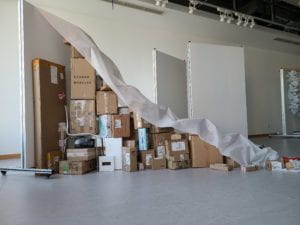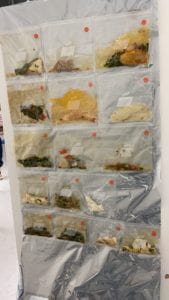PROJECT TITLE: Antithesis
PROJECT STATEMENT:
Remnants of Human Products
¡The artists want to recreate some ordinary but largely unnoticed objects from the past on earth. The artwork consists of two sides, one primarily through card boxes and packaging bags, and the other focuses on food waste. The two types of garbage are all byproducts of the fast-growing industry, but they speak for different points in the development.
On one side, the convenience provided by the delivery system comes with a bunch of waste. In a Fast company article published in 2018, “Amazon shipped more than 5 billion items worldwide last year through Prime alone.” From just one online retailer, we see the creation of countless packaging, including boxes and plastic buffers, and bags. It is doubtful if many or even a few of the packaging endure weeks after delivery. Also, the massive usage of the package causes damage to environmental resources like trees. The company article further expresses: “LimeLoop used data from USPS, FedEx, and UPS to estimate that around 165 billion packages are shipped in the U.S. each year, and then roughly calculated that the cardboard used would equate to more than 1 billion trees (this calculation didn’t account for the fact that some packaging is not made from paper or cardboard, but it gives a sense of scale). As online shopping continues to grow, so will the impact.” We were faced with this apparent overuse of trees and natural resources like fossil fuels, but we decided to ignore such warnings.
On the other side, we are engaged in the culinary world of the past. The immerse food waste experience shows the awful ramification of our wrongful behavior from the past. According to Future Direction, “Globally one-third of the food produced for human consumption – approximately 1.3 billion tons – is lost or wasted each year. Food loss and waste occur at various stages of the food supply chain, from harvest to the final stage of household consumption.” In all process of food, most food is wasted at the consumer stage.” outside of Chinese homes. Restaurants account for most food waste, with 19 percent of food waste attributed to these establishments and about five to seven percent of food wasted in homes or canteens.” The increasing food choice and the restaurant and shop’s marketing could be made our ancestors think that we did not need to worry about food supply anymore. But it is not. We now only have the options of Food tubes, tubes of energy intakes. The idea of culinary has become a part of history.
Of course, not all the “waste” from the past are “approachable.” The antithesis between the food and the packaging shows such contrast in different waste types in the past. The nature of development is a double-sword: convenience and waste of resources. Using these daily objects from life on earth, we want to illustrate a relatively realistic picture of the other world and the problems we once faced. Both the escalation of boxes and packaging in the front and the hanging food waste bag and videos in the back demonstrate such increasing warning levels in our past, and we decided not to solve it. We want to encourage people on this new planet to save a little bit more than they feel like. We can do better, whatever the format is.” On this new planet, we cannot go on this path again.
RESEARCH (Sproutworks)
Art Installation:
Problems Identified:
1. Tissue Usage
According to words from the staff working at Sproutworks:
Six boxes of tissues are needed per week on average. One box has 20 rolls or bags of tissues. Therefore, more than 120 rolls are used per week.
We observed that many students will take several tissues that exceed the number that they needed. Part of the reason is that it is hard to draw exactly one piece of tissue, especially when you are in a hurry, it is much likely that you will draw out more than you need. After using a piece of tissue, they found out that there are still some clean tissues, there will be three different kinds of solution. Some put them into their pocket, which we can assume that they are going to use these tissues later on. Others simply leave them on the table, but in most cases, the future users of that table will not tend to use them. And the third way, which is also the most popular way, is to rub the clean ones together with the dirty ones and throw them into the rubbish bin. This really brings about a lot of tissue waste. To talk about this issue in a much broader and macro way, this can be regarded as a waste of natural resources, which causes many future problems. For example, deforestation.
2. Cup Problem
According to words from the staff working at Sproutworks:
Sproutworks loses about 1000 cups every two months.
From last year, when the metal cups were first introduced and used by the Sproutworks in the NYU Shanghai community, half of the cups have been lost till now. Not only do students take them back home, but, what shocked us the most, some of the students even threw those metal cups into the garbage bin. It is hard to figure out the true reason behind their behavior. It could be that they did not know that those metal cups could be recycled. It could be that they did not notice that it was their responsibility to return those metal cups back to certain places.
3. Staff Scheduling
According to words from the staff working at Sproutworks:
The staff works from early morning to around 8 pm with a few hours of rest in the afternoon.
The staff working in the Sproutworks have to finish all the three shifts per day. Approximately, there are over 1,800 students eating in the cafeteria, therefore, during their working hours, they are quite busy, which we can easily imagine. Also, the nominated one-and-a-half working hours are far less than their working hours in reality. Beyond our expectations, their most important and time-consuming tasks are actually the food preparation before the canteen hours and the cleaning- up after people finish their meals. Therefore, between every two working shifts, they actually only have less than 1 hour to take a rest. To be worse, they do not even have a relaxation place, and the only possible small place for them to rest is the hard and cold meeting room next to the cafeteria.
CONCLUSIONS (Possible Solutions):
1. A machine to restrict the number of tissues taken at a time. / A tissue holder that has a narrower opening./ …
2. QR code on cups to prevent loss/ misplacing./ Usage of different cups, porcelain cups, or heavier cups (such as cups in IKEA cafe? )/ …
3. Create an app to increase the efficiency of meal preparation and cleanup.


